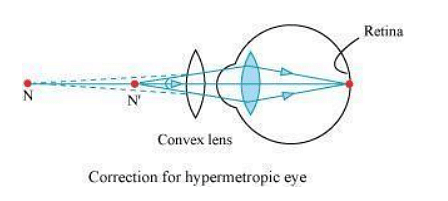Make a diagram to show how hypermetropia is corrected. The near point of a hypermetropic eye is 1 m. What is the power of the lens required to correct this defect? Assume that the near point of the normal eye is 25 cm.
Solution and Explanation
A person suffering from hypermetropia can see distinct objects clearly but faces difficulty in seeing nearby objects clearly. It happens because the eye lens focuses the incoming divergent rays beyond the retina. This defect of vision is corrected by using a convex lens. A convex lens of suitable power converges the incoming light in such a way that the image is formed on the retina, as shown in the following figure.
The convex lens actually creates a virtual image of a nearby object (N’ in the figure) at the near point of vision (N) of the person suffering from hypermetropia.
The given person will be able to clearly see the object kept at 25 cm (near point of the normal eye), if the image of the object is formed at his near point, which is given as 1 m.
Object distance, u = −25 cm
Image distance, v = −1 m = −100 m
Focal length, f
Using the lens formula,
\(\frac{1}{v}-\frac{1}{u}=\frac{1}{f}\)
\(\frac{1}{-100}-\frac{1}{-25}=\frac{1}{f}\)
\(⇒\frac{1}{f}=\frac{1}{25}-\frac{1}{100}\)
\(⇒\frac{1}{f}=\frac{4-1}{100}\)
\(⇒f=\frac{100}{3}=33.3\) cm
\(=0.33\) m
\(∴\text{Power,P}=\frac{1}{f}\text{(in metres)}\)
\(=\frac{1}{0.33}=+3.0\) D
A convex lens of power +3.0 D is required to correct the defect.
Top Questions on Defects Of Vision And Their Correction
- A 65-year-old diabetic woman presents with painless loss of vision. The ocular findings are shown in the image below. What is the likely diagnosis and management for this patient?

- NEET (PG) - 2023
- Ophthalmology
- Defects Of Vision And Their Correction
- The far point of a myopic person is 80 cm in front of the eye. What is the nature and power of the lens required to correct the problem?
- CBSE Class X
- Science
- Defects Of Vision And Their Correction
- What is meant by power of accommodation of the eye?
- CBSE Class X
- Science
- Defects Of Vision And Their Correction
- A person with a myopic eye cannot see objects beyond 1.2 m distinctly. What should be the type of the corrective lens used to restore proper vision?
- CBSE Class X
- Science
- Defects Of Vision And Their Correction
- A person needs a lens of power −5.5 diopters for correcting his distant vision. For correcting his near vision, he needs a lens of power +1.5 diopter. What is the focal length of the lens required for correcting?
(i) distant vision, and
(ii) near vision?- CBSE Class X
- Science
- Defects Of Vision And Their Correction
Questions Asked in CBSE X exam
- How did the Civil Disobedience Movement become a mass movement? Explain with examples.
- CBSE Class X - 2025
- Nationalism in India
- Name the method by which Amoeba and Leishmania reproduce. Write a major difference in the way they divide to produce new individuals.
- CBSE Class X - 2025
- How Do Organisms Reproduce
- Consider the following food chain:
Grass \( \rightarrow \) Grasshopper \( \rightarrow \) Frog \( \rightarrow \) Snake \( \rightarrow \) Eagle
If the amount of energy available at third trophic level is 50 kJ, the available energy at the producer level was:- CBSE Class X - 2025
- Life Processes
- Mijbil the Otter is portrayed as an intelligent, friendly, and playful animal who thrives on affection. Discuss how these traits are depicted in the story 'Mijbil the Otter' by Gavin Maxwell.
- CBSE Class X - 2025
- Mijbil the Otter
Analyze the significant changes in printing technology during 19th century in the world.
- CBSE Class X - 2025
- Print Culture and the Modern World